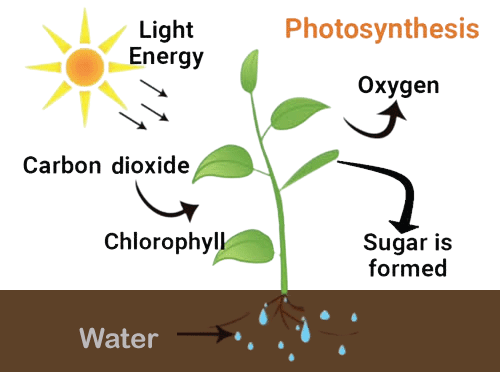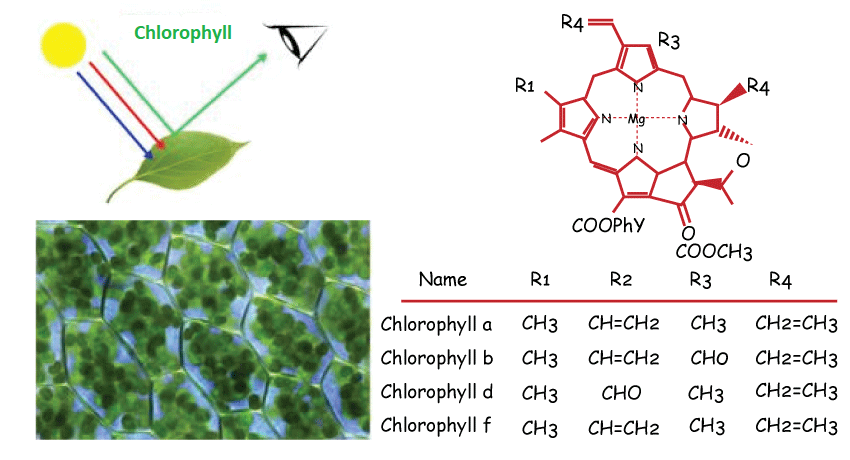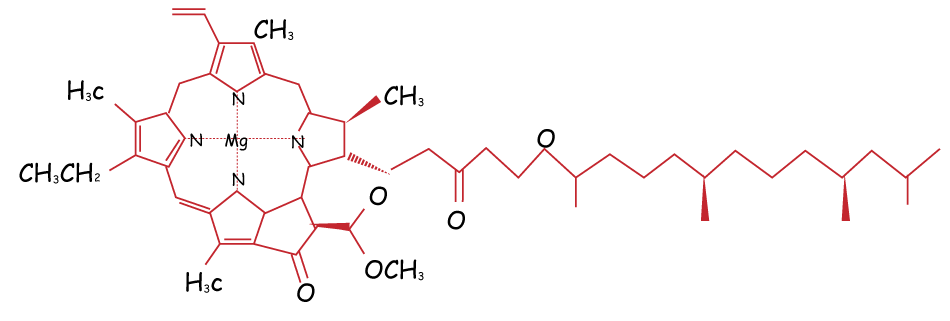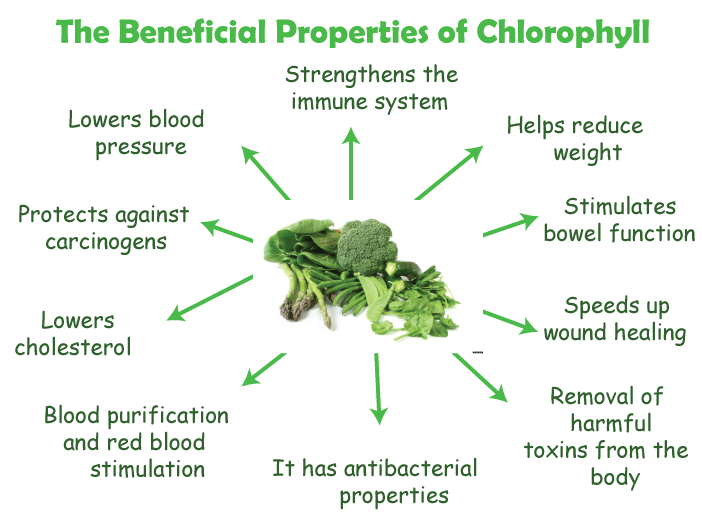Chlorophyll DefinitionChlorophyll is the green pigment found in plants and algae responsible for photosynthesis and has a long history of scientific discovery. In 1817, Joseph Bienaime Caventou and Pierre Joseph Pelletier first separated and named chlorophyll. However, it wasn't until 1906 that magnesium had discovered to be a component of chlorophyll located within living tissue. 
German scientist Richard Willstatter began work on understanding the structure of chlorophyll from 1905 to 1915. When Hans Fischer clarified the general design of chlorophyll A in 1940, significant progress had been made in understanding its stereochemistry. Ian Fleming completed the final stereochemical explanation for chlorophyll A in 1967. In 2010, Chlorophyll F was discovered to be present in cyanobacteria and some additional oxygenic microorganisms that form stromatolites with a molecular formula C55H70O6N4Mg. Read more information regarding chlorophyll and its types. Significant Information Regarding Chlorophyll
Interestingly, the chlorophyll content of green plants varies depending on their shade of green. The greener the vegetable or plant, the higher its concentration of the vital compound. Additionally, it's worth noting that there are two main types of chlorophyll: chlorophyll A and B. Despite being distinct molecules, both varieties share some standard features. They are fat-soluble compounds with potent antioxidant properties that help protect plants from oxidative stress caused by environmental factors like UV radiation. Chlorophyll Structure
Chlorophyll is a group of pigments that play an indispensable role in photosynthesis (the procedure by which plants convert light energy into chemical energy). While there are only a few known types of chlorophylls, they all share some common characteristics. For example, they all have a fifth ring containing ketones attached to their four pyrrole-like rings, distinguishing them from other related pigments. Most chlorophylls belong to the family of porphyrins and share similar biosynthetic pathways with them. Both pathways start from uroporphyrinogen III as their precursor molecule. Nevertheless, unlike hemes that involve iron bound to the N4 centre, most chlorophylls bind magnesium instead. The ligands attached to Mg2+ centres can vary depending on the chlorophyll type but are often omitted for clarity purposes. Chlorophyll molecules also have different side chains attached to their central ring structure; these typically include long phytyl chains (C20H39O). Chlorophyll A is the most commonly found form in terrestrial plants and differs from its counterpart chlorophyll b by having a methyl group rather than a formyl group. This difference causes significant changes in absorption spectra and allows plants to absorb more. Chlorophyll Synthesis
Chlorophyll is synthesized inside the chloroplast from a copious forerunner, namely glutamate, which undergoes several reactions to form tetrapyrrole protoporphyrin IX. This pathway branches among chlorophyll and heme, with the responses happening in the plastid stroma and being catalyzed by dissolvable proteins. The first step towards chlorophyll synthesis involves the inclusion of the focal magnesium particle, which occurs with chemical edifices that have restrictions on membranes. Magnesium chelatase is a vital compound comprising a solvent and membrane-bound subunits in this pathway. The resulting reactions primarily occur by these subunits and involve the modification of underlying groups on the edge of the molecule. Protochlorophyllide is reduced by NADPH to chlorophyllide in the primary reaction in this biosynthetic pathway that requires light. Light-dependent NADPH: protochlorophyllide oxidoreductase catalyzes this reaction and changes the property of atoms allowing products like chlorophyllide to interact with proteins forming complex structures called "chlorophyll-protein" complexes. Different Kinds of ChlorophyllThere are several kinds of chlorophyll, which are as follows; 1) Chlorophyll A Chlorophyll A is an intense pigment in every higher plant and plays a crucial role in photosynthesis. However, it's not just limited to plants; certain types of algae, cyanobacteria, and anaerobic phototrophs also contain this essential pigment. Chlorophyll A has specific regions of absorption that make it highly efficient at capturing light energy for the process of photosynthesis. Interestingly, chlorophyll A can absorb violet-blue and orange-red light wavelengths while reflecting blue-green light. This unique ability allows plants to maximize their energy intake from sunlight by efficiently utilizing different parts of the visible spectrum. It's fascinating how nature has evolved such sophisticated mechanisms to harness solar energy! 2) Chlorophyll B Chlorophyll B is a green pigment in plants that helps chlorophyll A absorb light. It has a unique colour and absorbs orange-red light while reflecting yellow-green tones. Chlorophyll B has a CHO group in its chlorin ring, while Chlorophyll A has CH3. This difference affects how they interact with light and their roles in photosynthesis. 3) Chlorophyll C Chlorophyll C is a pigment mostly found in marine algae. Interestingly, it has been observed in various species, such as brown algae, diatoms, and dinoflagellates. The presence of chlorophyll c can be attributed to the porphyrin ring within its structure. Furthermore, this chlorophyll shade can be classified into three sub-types: chlorophyll c1, c2, and c3. Each of these subtypes exhibits differences not only in their chemical composition but also in their assimilation rates. 4) Chlorophyll D One type of chlorophyll is chlorophyll D, only found in red algae and cyanobacteria living in deep water environments where red light quickly penetrates. These organisms are unique among other types of algae because they can use red light for photosynthesis. 5) Chlorophyll E Chlorophyll E is a type of chlorophyll found in specific green and yellow-green algae called Xanthophytes. But, its properties are still being studied to understand its function. 6) Chlorophyll F Researchers have discovered a new type of chlorophyll called Chlorophyll F that can absorb infrared radiation beyond the visible spectrum. It offers exciting possibilities for future research on its potential applications. Is there any Difference between Chlorophyll A and Chlorophyll B?Chlorophyll A and Chlorophyll B are two types of pigments found in plants that play a crucial role in the process of photosynthesis. Although they have similar functions, there are several differences between them.
Chlorophyll Uses1) Skin Benefits It has become increasingly popular owing to its possible advantages in treating a plethora of health conditions. Several clinical examinations have recommended that it could be helpful for skin conditions, personal stenches, and battling malignant growth. One of the most exciting findings is that effective chlorophyll might function as an anti-ageing cure. A recent study discovered that applying a gel containing chlorophyllin to the skin reduced indications of photoaging, which is ageing resulting from sun exposure. One research also found that a gel containing chlorophyllin considerably decreased facial acne as well as large visible pores. 2) Blood Properties The other most exciting benefit of chlorophyll is its similarity to haemoglobin - a protein that plays an essential role in red blood cells by carrying oxygen throughout the body. Moreover, Researchers have recommended that wheatgrass juice, which is highly rich in chlorophyll, could be more advantageous in treating haemoglobin deficiency issues like thalassemia and iron deficiency. 3) Wound Healing Properties Chlorophyll has multiple benefits due to its wound-healing properties. In fact, during the 1940s and 1950s, researchers focused on using chlorophyll as a tool for healing wounds. Some studies suggested that it might help heal surgical wounds and prevent infections. A more recent review from 2008 indicated that medication containing chlorophyllin promotes wound healing and reduces odours associated with certain types of damage. In addition to these benefits, there are some indications that chlorophyll may have potential as a cancer treatment. ConclusionChlorophyll is essential in photosynthesis, absorbing light energy and converting it into chemical energy for plants to produce glucose and oxygen. It also has health benefits for humans, such as acting as an antioxidant, detoxifying the liver, improving digestion, and reducing bad breath. Overall, understanding the importance of chlorophyll in plants provides us with insight into how they function and survive in different environments. By incorporating more greens into our diets, we can also reap some potential health benefits associated with this remarkable molecule.
Next TopicEngineering Definition
|
 For Videos Join Our Youtube Channel: Join Now
For Videos Join Our Youtube Channel: Join Now
Feedback
- Send your Feedback to [email protected]
Help Others, Please Share










